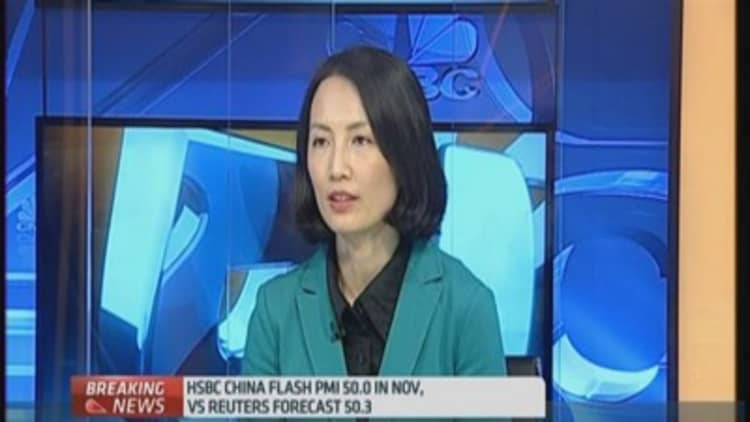
China's factory activity stalled in November as output shrank for the first time in six months, a private survey showed on Thursday.
The HSBC flash Purchasing Managers' Index (PMI) for November clocked in at the breakeven level of 50.0 that separates expansion from contraction, compared with a Reuters estimate for 50.3 and following the 50.4 final reading in October.
Overall, new orders picked up slightly but new export orders slowed markedly, dragging on activity. The factory output sub-index fell to 49.5, the first contraction since May.
Read MoreWhy China won't be Asia's dominant power
The Australian dollar eased against the greenback on the news, trading at $0.8607. But shares in China and Hong Kong appear unaffected by the data.
The reading is the latest evidence that the world's second biggest economy continues to lose traction. Recent data on housing prices and foreign direct investments also missed forecasts.
"China is slowing and we think it will continue to slow. A lot of it is structural, and in our view, growth will slow to about 4.5 percent over the next 10 years. We see some sectors that are very challenged; clearly real estate is one," Robin Bew, MD of Economist Intelligence Unit, told CNBC.
Read MoreDid China just grant one-of-a-kind trade status?
Beijing has signaled increased tolerance towards slower growth as the economy transitions away from heavy investments and towards a more sustainable model of consumption-fueled expansion.
As such, authorities supported the economy in recent months with targeted easing rather than aggressive measures like interest rates cuts or lowering banks' reserve requirement ratio.
China's top economic planning body said on Wednesday that the economy faces increasing downward pressure in 2015, while the cabinet promised help lower funding costs by giving banks more flexibility to lend.
China's gross domestic product grew at an annual rate of 7.3 percent in the third quarter, the slowest pace since the first quarter of 2009, when China's growth rate slumped to 6.6 percent amid the depths of the global financial crisis. The government has a growth target of around 7.5 percent for 2014.
Read More'New Silk Road' highlights China's two-speed reform
According to Helen Qiao, chief economist of Greater China at Morgan Stanley, the latest PMI reading isn't that dismal as it was affected by seasonal factors, particularly the APEC summit which took place in Beijing early November.
"There was impact from the so-called 'APEC blues.' There were a lot of suspensions in factory activities in up to six provinces around Beijing. I suspect that this number might be slightly better if we can adjust for that impact," said Qiao.

